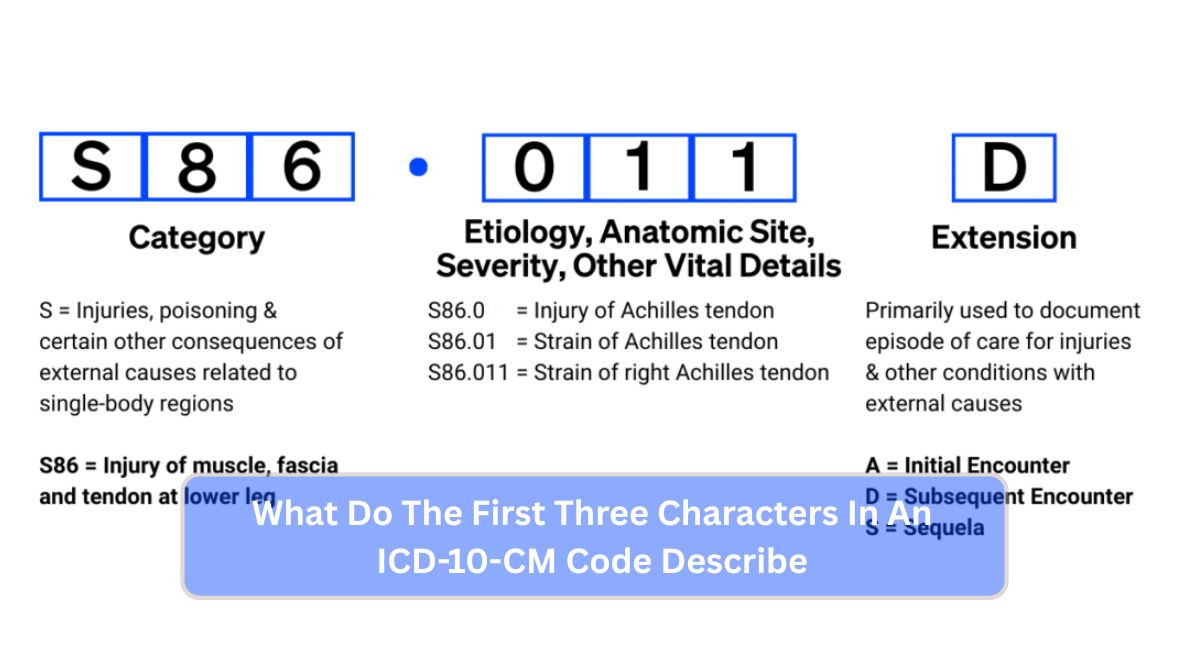ICD-10-CM codes are an essential part of the healthcare system, especially in medical billing, diagnostics, and reporting. These codes are used by hospitals, doctors, insurance providers, and even governments to accurately classify and document diseases and conditions. But if you’re just getting started with ICD-10-CM codes, you may wonder, what do the first three characters in an ICD-10-CM code describe? This blog post explores the answer in detail, using simple English to make it easy to understand.
Key Points:
- The first three characters of an ICD-10-CM code describe the category of the disease.
- These characters are a combination of one letter followed by two numbers.
- They help group similar conditions for medical and billing purposes.
What Is The Structure Of An ICD-10-CM Code?
ICD-10-CM codes are alphanumeric and usually contain between 3 and 7 characters. The first three characters are the most critical because they define the category of the condition. For example, in the code “A01,” the “A” refers to a specific chapter in ICD-10-CM related to infectious and parasitic diseases, and the “01” further narrows it down to a condition like typhoid fever.
To illustrate:
| ICD-10-CM Code | Description |
|---|---|
| A01 | Typhoid and paratyphoid fevers |
| E11 | Type 2 diabetes mellitus |
| J45 | Asthma |
Reminder: Always review the most current version of ICD-10-CM to ensure accurate coding.
These codes help categorize and group similar diseases, making it easier to analyze and record medical information. Healthcare professionals rely on this coding system for everything from patient care to administrative tasks.
How Do The First Three Characters Help In Diagnosis?
The first three characters of an ICD-10-CM code are foundational to the diagnostic process. When a patient visits a hospital or clinic, healthcare providers must document their symptoms and determine a diagnosis. These characters allow providers to quickly categorize the condition, whether it’s related to the respiratory system, digestive system, or mental health.
For example:
- Code “F32” refers to depressive episodes.
- Code “I10” refers to essential (primary) hypertension.
Here’s a comparison table showing categories and what they represent:
| First Character | Chapter | Example Code |
| F | Mental and behavioral disorders | F32 |
| I | Circulatory system | I10 |
| K | Digestive system | K35 |
Note: Accurate diagnosis depends on the correct use of these initial characters.
In medical practice, choosing the right code can affect the treatment path, insurance claims, and overall patient care. Misclassification can lead to denied claims or inappropriate treatment.
Why Are These Codes Important For Billing And Insurance?
The use of the first three characters in an ICD-10-CM code goes beyond diagnosis—they play a major role in billing and insurance. Medical institutions must submit codes to insurers for reimbursement. If the code doesn’t accurately represent the diagnosis, the claim may be rejected.
Insurance companies analyze the code category to verify the necessity of the treatment provided. For example, a surgery billed under a code beginning with “J” (which refers to respiratory conditions) wouldn’t make sense if the procedure was for a broken bone (which falls under “S” codes).
This system reduces fraud and ensures fairness in claims processing. It also allows for the collection of accurate health data at national and global levels.
Are There Examples Of Common ICD-10-CM Categories?
Yes, many categories are commonly used. Here are a few examples:
- A00–B99: Certain infectious and parasitic diseases
- C00–D49: Neoplasms (tumors and cancers)
- E00–E89: Endocrine, nutritional, and metabolic diseases
These categories are broad but become specific as characters are added. For instance, “E11” is a general code for Type 2 diabetes, but “E11.9” may specify it without complications.
Each group helps doctors and medical coders identify and treat patients efficiently. This hierarchical structure allows for better management and classification of a wide range of health conditions.
How Can Medical Students And Professionals Learn These Codes Efficiently?
Medical students and healthcare workers must be fluent in ICD-10-CM coding. Many institutions offer training sessions and coding certifications to help them learn. Mnemonic devices, online practice tools, and real-world exposure help in remembering and applying these codes.
Tips to learn:
- Use flashcards with code and description.
- Categorize codes based on body systems.
- Practice with sample patient cases.
Learning starts with understanding the structure, especially the first three characters. Once these are mastered, it’s easier to decode the rest.
Conclusion
Understanding what the first three characters in an ICD-10-CM code describe is vital for effective medical practice, billing, and patient care. These initial characters lay the foundation for disease classification and are used extensively by medical professionals worldwide. Whether you’re a student, a doctor, or an insurance worker, knowing this coding structure helps in accuracy, efficiency, and better healthcare service.
FAQ’s
1. What do the first three characters in an ICD-10-CM code mean? They represent the category of a disease or health condition.
2. Why is it important to understand ICD-10-CM code structure? It helps in proper diagnosis, treatment, and billing.
3. Are ICD-10-CM codes the same worldwide? No, some countries use modified versions, but the structure remains similar.
4. Who uses ICD-10-CM codes? Doctors, medical coders, hospitals, and insurance companies use them.
5. Can a code’s first three characters affect insurance claims? Yes, incorrect codes can lead to denied claims or delays in reimbursement.




